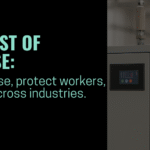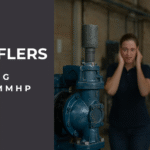What is a Pneumatic Silencer? – A Simple Guide by MMHP India
When machines work, they can sometimes make loud noises. These sounds happen when air is pushed out of the machine quickly. This loud noise is not just annoying—it can also hurt people’s ears if they hear it all the time.
At MMHP India, we care about making machines safer and quieter. That’s why we offer pneumatic silencers. These small tools help reduce loud air sounds from machines. Let’s learn more about them in a simple way!
What is a Pneumatic Silencer?
A pneumatic silencer is a small part you put on a machine. Its job is to make loud air sounds quieter when the air comes out. Imagine blowing air through a whistle—it’s loud, right? Now, if you blow air through a sponge, it’s soft and quiet. That’s kind of how a pneumatic silencer works!
When air leaves a machine very fast, it makes a “psshhh!” sound. A pneumatic silencer slows the air down and spreads it out, so it doesn’t make that loud sound.
Why Do We Need Silencers?
To Protect People’s Ears
Loud sounds can hurt hearing. In factories where machines work all day, people hear these noises again and again. Pneumatic silencers help keep sound levels safe.
To Make Workplaces Better
A quiet machine helps everyone focus better. It also makes the workspace more peaceful and less stressful.
To Keep the Environment Clean
Some pneumatic silencers can also trap tiny dust or oil particles in the air, helping keep the air clean.
Where are Pneumatic Silencers Used?
At MMHP India, we make pneumatic silencers that work great with:
- Air compressors
- Pneumatic cylinders
- Valves
- Air tools
- Industrial machines
Basically, anywhere that air is released fast, our pneumatic silencers can be used to make it quieter.
How Does a Pneumatic Silencer Work?
Let’s break it down like a simple science experiment!
- Air goes in: The machine pushes out fast air.
- It passes through the pneumatic silencer: Inside the pneumatic silencer is a special material with tiny holes.
- The air slows down: These tiny holes spread out the air and slow it down.
- Less noise comes out!
It’s kind of like blowing through a straw into a sponge. The sponge absorbs the air and the sound.
What Are MMHP Pneumatic Silencers Made Of?
At MMHP, we make pneumatic silencers using:
- Sintered bronze
- Plastic (Polyethylene)
Let’s look at each one:
Sintered Bronze Silencers
- Strong and Durable: They last a long time.
- Work well in high temperatures
- Can be cleaned and reused
- Resist rust and corrosion
- Perfect for tough industrial jobs
These are the most common pneumatic silencers at MMHP India.
Plastic Silencers (Polyethylene)
- Lightweight
- Lower cost
- Great for light-duty machines
- Simple design
These are good for smaller machines or jobs that don’t get too hot.
Types of Pneumatic Silencers We Offer at MMHP
We offer different types of pneumatic silencers depending on your machine and how it works. Here are some of the types we provide:
- Threaded Silencers
These are screwed into place directly on the machine’s outlet. - Muffler Type Silencers
These look like tiny mufflers and spread air over a wide area to reduce noise. - Filter Type Silencers
These not only reduce noise but also filter dust and particles in the air.
Each of these pneumatic silencers is made to fit perfectly into different kinds of machines. We can help you choose the right one!
How to Choose the Right Silencer?
Picking the right pneumatic silencer is like choosing the right school bag—it has to fit your needs!
Think about:
- How much air pressure is used?
- How big is the machine?
- How hot does it get?
- Do you need to filter the air too?
- How loud is the noise now?
Our experts at MMHP India can help guide you. Just share what kind of machine you’re using, and we’ll find the best fit for you.
Can You Clean and Reuse a Silencer?
Yes, especially our sintered bronze pneumatic silencers! These are built to last and can be cleaned if they get dusty or oily.
How to Clean:
- Remove the pneumatic silencer from the machine.
- Use compressed air to blow out dust.
- Or soak in a cleaning liquid (like alcohol or thinner).
- Let it dry completely before using again.
Cleaning helps keep the pneumatic silencer working well for a long time!
What Happens If You Don’t Use a Silencer?
If you don’t use a pneumatic silencer, your machine will make a lot of noise. This can:
- Hurt ears
- Make people feel tired or stressed
- Cause air pollution
- Break safety rules in the factory
That’s why many companies now make pneumatic silencers a must-have!
Why Choose MMHP India Silencers?
MMHP India is a trusted name in pneumatic tools and parts. Here’s why our pneumatic silencers are special:
✅ Made from top materials like sintered bronze
✅ Perfect size and fit for Indian and international machines
✅ Strong, long-lasting, and easy to clean
✅ Affordable prices
✅ Expert support to help you choose the right one
✅ Fast delivery all over India
We believe in quality + care. Every pneumatic silencer we make is checked to be sure it works just right.
Need Help Choosing One?
Don’t worry if you’re not sure which pneumatic silencer is best. You can contact our friendly team at MMHP India, and we’ll help you pick the right one.
- Call us
- Email us
- Visit our website: https://mmhpindia.com
We’re here to help make your machines quieter, safer, and better!
Summary (For Quick Recall)
| Thing to Know | Simple Answer |
| What is a pneumatic silencer? | A part that reduces loud air noise from machines |
| Why use it? | To protect ears, keep workplaces quiet, and clean air |
| Where to use? | Any machine that releases fast air |
| What is it made of? | Bronze or plastic |
| Can you reuse it? | Yes, clean it and use it again |
| Who makes them? | MMHP India – strong, smart, and silent silencers! |
Final Thoughts
Machines don’t have to be noisy. With a little tool like a pneumatic silencer from MMHP India, you can make big changes—less noise, more safety, and better air.
Let’s make the world a little quieter, one pneumatic silencer at a time.





